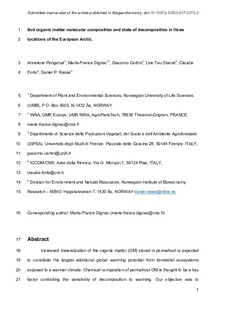| dc.description.abstract | Increased mineralization of the organic matter (OM) stored in permafrost is expected to constitute the largest additional global warming potential from terrestrial ecosystems exposed to a warmer climate. Chemical composition of permafrost OM is thought to be a key factor controlling the sensitivity of decomposition to warming. Our objective was to characterise OM from permafrost soils of the European Arctic: two mineral soils—Adventdalen, Svalbard, Norway and Vorkuta, northwest Russia— and a ‘‘palsa’’ (ice-cored peat mound patterning in heterogeneous permafrost landscapes) soil in Neiden, northern Norway, in terms of molecular composition and state of decomposition. At all sites, the OM stored in the permafrost was at an advanced stage of decomposition, although somewhat less so in the palsa peat. By comparing permafrost and active layers, we found no consistent effect of depth or permafrost on soil organic matter (SOM) chemistry across sites. The permafrost-affected palsa peat displayed better preservation of plant material in the deeper layer, as indicated by increasing contribution of lignin carbon to total carbon with depth, associated to decreasing acid (Ac) to aldehyde (Al) ratio of the syringyl (S) and vanillyl (V) units, and increasing S/V and contribution of plant-derived sugars. By contrast, in Adventdalen, the Ac/Al ratio of lignin and the Alkyl C to O-alkyl C ratio in the NMR spectra increased with depth, which suggests less oxidized SOM in the active layer compared to the permafrost layer. In Vorkuta, SOM characteristics in the permafrost profile did not change substantially with depth, probably due to mixing of soil layers by cryoturbation. The composition and state of decomposition of SOM appeared to be site-specific, in particular bound to the prevailing organic or mineral nature of soil when attempting to predict the SOM proneness to degradation. The occurrence of processes such as palsa formation in organic soils and cryoturbation should be considered when up-scaling and predicting the responses of OM to climate change in arctic soils. | nb_NO |
